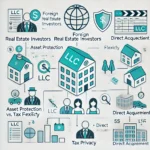How Florida’s Financial Capital is Redefining Luxury Real Estate in the Americas
Miami’s real estate market has experienced a decade of growth in just two years during the pandemic, with an average 57% increase in luxury home prices between 2020 and 2022, according to data from the Miami Association of Realtors. This unprecedented transformation is redefining not only the city’s skyline, but also its economic and demographic profile.
Miami’s current scenario represents a fundamental change in the American real estate market. The city is emerging as a new financial epicenter, attracting not only retirees in search of a pleasant climate, but mainly executives in full swing and entire companies choosing the region as their new operational base.
As a specialist in international financial and tax structuring, I have observed a growing interest from foreign investors looking to strategically position themselves in this changing market. The combination of top-notch infrastructure, Florida’s favorable tax regime and unique lifestyle has created a perfect environment for high-end real estate investments.
This article offers an in-depth analysis of the opportunities and challenges of this evolving market, with a special focus on the implications for international investors and structuring real estate investments in the US.
Target Audience
This content is especially relevant for
Executives considering relocating to Florida
International investors interested in the US real estate market
Family offices managing family wealth
Real estate developers looking for opportunities in the US
Financial and tax advisors with clients interested in Miami
Part 1: Ready to Roll 🚀 – Basic Strategies and Practical Actions
Part 1, “Ready to Roll”, offers practical actions and immediate advice for entrepreneurs who need quick and effective guidance.

1. Fundamental Concepts
The Miami real estate market has unique characteristics that need to be understood:
A. Market valuation
Miami’s real estate market presents a unique dynamic of appreciation that needs to be understood in depth. During the pandemic, we saw an unprecedented acceleration, with areas such as Brickell registering appreciation of more than 60% in just 24 months. This appreciation has not been uniform: while luxury residential properties on the waterfront have seen price increases of more than 80%, other areas of the city have experienced more moderate growth, in the 30-40% range. To understand this phenomenon, we need to look at three main factors: population migration, infrastructure development and changes in the region’s economic profile.
For example, a 200m² apartment in Brickell that cost $2 million in 2019 can now be worth more than $3.2 million. This increase reflects not only the natural appreciation of the market, but also significant improvements to the local infrastructure, such as the expansion of the public transport system and the development of new commercial and cultural centers.
B. Investment Structures
Choosing the right structure for real estate investment in Miami is crucial to optimizing returns and minimizing risks. For international investors, the most common structure has been the Limited Liability Company (LLC) established in Delaware or Florida, often combined with an offshore holding company. This combination offers robust legal protection and tax efficiency.
Consider the example of a Brazilian investor who decides to buy a $5 million apartment in Miami Beach. Establishing an LLC in Florida as the direct owner of the property, held by a holding company in the Cayman Islands, can offer significant asset protection and flexibility in succession planning. This structure also facilitates future financing and allows for greater privacy in transactions.
C. Regulatory Aspects
Miami’s regulatory environment has particularities that may surprise international investors. The city operates under a complex zoning system that divides the region into specific districts, each with its own building and use regulations. The Miami 21 Zoning Code, for example, establishes specific guidelines for building height, population density and permitted uses in each area.
A developer planning to build a commercial building in Brickell needs to navigate multiple layers of approvals, including the Miami Planning and Zoning Board, Miami-Dade County Environmental Resources Management, and potentially the Federal Aviation Administration, due to the proximity to airports. The entire process can take 12 to 24 months, depending on the complexity of the project.
2. Initial Strategies
A. Market Analysis
Market analysis in Miami requires an in-depth understanding of the different micro-regions and their specific dynamics. Brickell, for example, has emerged as the new financial center not only for Miami, but for all of Florida. With the arrival of financial institutions such as Citadel, Blackstone and Goldman Sachs, the region has experienced a radical transformation in its commercial and residential profile.
To illustrate: a recent study by the Miami Downtown Development Authority showed that more than 60 financial companies have established offices in Brickell in the last two years, creating an unprecedented demand for class A commercial space and high-end residences. This change is driving new developments such as Mercedes-Benz Places and 888 Brickell Dolce & Gabbana.
B. Structuring Investments
The proper structuring of real estate investments in Miami requires a multidisciplinary approach that considers legal, tax and inheritance aspects. For example, a European investor wishing to acquire a portfolio of commercial properties in Miami may benefit from a layered structure that includes a domestic REIT (Real Estate Investment Trust) combined with an offshore structure.
This approach allows for tax optimization – especially considering the tax benefits offered by Florida – while maintaining flexibility for future developments or sales. For example, a well-planned structure can reduce exposure to FIRPTA (Foreign Investment in Real Property Tax Act) and facilitate future transactions.
3. Practical Implementation
Due diligence in the Miami real estate market requires special attention to several critical aspects. Firstly, title verification must go beyond simply looking for encumbrances: it is necessary to understand the full history of the property, including environmental issues and zoning restrictions that could impact future developments.
For example, a historic building in Miami Beach may be subject to specific preservation restrictions that significantly limit the possibilities for renovation or development. Similarly, properties in coastal areas need to consider strict environmental regulations and building requirements related to hurricanes and sea level rise.
The financial analysis should include not only traditional return projections, but also consider factors specific to the Miami market, such as insurance costs (which can be significant in coastal areas), property taxes (which vary significantly by region) and potential climate change adaptation costs.
A practical example would be developing a detailed timeline for a retrofit project on an existing building in South Beach:
Month 1-2: Initial due diligence and feasibility analysis
- Complete title check
- Structural evaluation
- Historical constraints analysis
Month 3-4: Planning and approvals
- Submission of preliminary plans
- Consultations with regulatory bodies
- Development of detailed budget
Month 5-6: Implementation
- Hiring suppliers
- Obtaining final permits
- Start of construction
Part 2: Deep Dive 🤿 – Technical Delving into Advanced Strategies
Part 2, “Deep Dive”, provides in-depth analysis for those who want to dive into the technical and complex aspects of international finance.

4. In-depth Technical Analysis
A. Market Trends and Corporate Migration
The current phenomenon in Miami represents a unique convergence of economic, demographic and social factors that are redefining the real estate market. To fully understand this moment, we need to analyze each component separately.
- Impact on Commercial Prices
The evolution of commercial prices in Miami is not just a question of numbers, but a reflection of a fundamental transformation in the city’s economic profile. Let’s analyze this evolution by district:
Brickell Financial District: 2019 (Pre-pandemic):
- Class A: $55-65/square foot/year
- Class A: $45-55/square foot/year
- Class B : $35-45/square foot/year
- Vacancy rate: 12%
2024 (Current):
- Class A : $125-150/square foot/year
- Class A: $100-125/square foot/year
- Class B : $75-90/square foot/year
- Vacancy rate: 3.5%
This appreciation represents not just an increase in prices, but a complete reconfiguration of the market. For example, the 830 Brickell building has established a new paradigm by signing contracts worth more than $150/square foot/year with companies such as Citadel and Microsoft. This price level was previously considered impossible in the Miami market.
Downtown Miami: 2019 (Pre-pandemic):
- Class A: $38-45/square foot/year
- Class B: $28-35/square foot/year
- Vacancy rate: 15%
2024 (Current):
- Class A: $75-90/square foot/year
- Class B: $55-70/square foot/year
- Vacancy rate: 8%
Miami Beach: 2019 (Pre-pandemic):
- Class A: $50-60/square foot/year
- Class B: $40-50/square foot/year
- Vacancy rate: 10%
2024 (Current):
- Class A: $90-120/square foot/year
- Class B: $70-85/square foot/year
- Vacancy rate: 5%
Driving Factors:
(a) Corporate Demand: The profile of companies looking for space in Miami has changed dramatically. Previously dominated by regional companies and Latin American banks, the market now attracts:
- Top-tier hedge funds
- Global investment banks
- Growing technology companies
- International family offices
b) Space shortage: The limited supply of class A space is creating unprecedented pressure on prices:
- Only 2.1 million square feet under development
- 65% pre-let rate for new projects
- Average absorption time reduced from 12 to 4 months
c) Construction Costs: Rising construction costs are impacting the development of new projects:
- 35% increase in material costs since 2019
- Shortage of skilled labor
- Stricter construction and sustainability requirements
- Demand for corporate space
The nature of demand for corporate space in Miami has undergone a fundamental transformation. Let’s take a look at the main changes:
Leasing Profile:
2019:
- Average size: 5,000-10,000 square feet
- Average term: 5-7 years
- Typical improvements: $50-75/square foot
- Guarantees: 6-12 months rent
2024:
- Average size: 15,000-30,000 square feet
- Average term: 10-15 years
- Typical improvements: $150-200/square foot
- Collateral: Corporate letters of credit
Sectoral Distribution of Demand:
Financial sector (45% of demand):
- Hedge funds: 20%
- Investment banks: 15%
- Private equity: 10%
Technology (25% of demand):
- Fintech: 12%
- Software: 8%
- Blockchain/Crypto: 5%
Professional Services (20% of demand):
- Law firms: 10%
- Consultancies: 7%
- Accounting: 3%
5. Technology and Automation
Miami’s real estate sector is experiencing a technological revolution that goes far beyond simple automation. Let’s take a look at how these innovations are transforming the market:
- Smart Building Technologies
The integration of smart technologies into modern Miami buildings is creating a new standard of efficiency and user experience. Let’s examine the main systems and their impacts:
AI-Based Energy Management Systems:
Performance Metrics:
- Average consumption reduction: 35-45%
- Typical ROI: 24-36 months
- Operating cost reduction: $2-3/square foot/year
Key components:
- Distributed IoT sensors
- Adaptive HVAC systems
- Smart lighting
- Real-time monitoring
Practical example: Mercedes-Benz Places implemented an AI system that learns from the building’s usage patterns and automatically adjusts the systems. Results from the first year of operation:
- Energy savings: 42%
- Reduction in operating costs: $1.2 million
- Improvement in occupant satisfaction: 35%
Real-time occupancy monitoring:
Technologies implemented:
- Wireless occupancy sensors
- Cameras with AI video analysis
- Biometric access control systems
- Real-time heat mapping
Measurable benefits:
- Space optimization: 25% increase in efficiency
- Reduced cleaning costs: 30%
- Improved security: 40% fewer incidents
- Advanced Management Platforms
New management platforms are revolutionizing the way real estate assets are managed in Miami:
Asset Management Platforms:
Core capabilities:
- Predictive analytics
- Preventive maintenance management
- Real-time revenue optimization
- Integration with blockchain for contracts
Example of implementation at 888 Brickell:
- System: Proprietary integration with IBM Watson
- Initial investment: $2.5 million
- Projected ROI: 185% in 5 years
B. Analytics and Big Data
The use of data is transforming decision-making in the Miami real estate market:
- Predictive Market Analysis:
Data sources:
- Historical transactions
- Demographic data
- Economic metrics
- Social media data
- Mobility patterns
Models used:
- Supervised machine learning
- Neural networks
- Time series analysis
- Advanced regression models
Practical results:
- Forecast accuracy: 92% for price trends
- Anticipation of market changes: 3-6 months
- Opportunity identification: 45% more efficient
6. Risk Management
Risk management in the Miami real estate market requires a sophisticated and multifaceted approach:
A. Quantitative Risk Analysis
- Value at Risk (VaR) models:
Model components:
- Price history
- Market volatility
- Correlations between assets
- Macroeconomic factors
Key metrics:
- Daily VaR: 95% confidence
- Stressed VaR: extreme scenarios
- Expected Shortfall (ES)
- Conditional VaR
- Stress Testing:
Scenarios tested:
- Severe economic recession
- Significant increase in interest rates
- Extreme weather events
- Regulatory changes
Methodology:
- Monte Carlo simulations
- Sensitivity analysis
- Scenario testing
- Historical backtesting
B. Mitigation Strategies
- Portfolio diversification:
Geographical strategies:
- Sub-market mix
- Distribution by asset type
- Tenant diversification
- Multiple exit strategies
- Financial hedging:
Instruments used:
- Interest rate swaps
- Real estate index options
- Specialized insurance
- Weather hedge contracts
7. Compliance and Regulation
A. Regulatory Framework
- Structural compliance:
Main requirements:
- Appropriate licensing
- Regulatory records
- Periodic reports
- Independent audits
- Due diligence:
Established processes:
- Verification of source of funds
- Counterparty analysis
- Environmental assessment
- Tax compliance
Conclusion
Miami is experiencing a historic transformation, evolving from a tourist and retirement destination into a global financial center. With more than $15 billion in new developments planned over the next five years, the city offers unique opportunities for international investors.
Success in Miami’s real estate market will depend on the ability to understand and navigate its peculiarities, implement appropriate structures and keep up to date with market trends.
FAQs
Q: What are the main investment vehicles for foreigners? A: The most common structures include LLCs, corporations and trusts, each with its own specific advantages depending on the investor’s objectives and tax considerations.
Q: How does the approval process work for new developments? A: The process involves multiple stages of municipal and state approval, including zoning, environmental impact and building permits.
Q: What are the main tax considerations? A: Investors should consider property taxes, capital gains and proper structuring to minimize the tax burden within legal limits.
Q: How does the Miami market compare to other US markets? A: Miami offers a unique combination of favorable tax regime, economic growth and attractive lifestyle, setting it apart from other major markets.
Q: What is the expected impact of corporate migration? A: Corporate migration should continue to drive demand for high-end commercial and residential space, sustaining market growth.
Contact us
For expert advice on real estate investments:
- Email: [email protected]
- Phone/WhatsApp: 1 (561) 867-9797
- Website: kwikledgers.com
- LinkedIn: www.linkedin.com/in/kleyton-tartarotti-66238317b

Member of the IMA (Institute of Management Accountants) – USA
Member of the AICPA (American Institute of CPAs) – USA
Member of AAII (American Association of Individual Investors) – USA
Member of AAA (American Accounting Association) – USA
Member of the FMA (Financial Management Association) – USA
These associations not only attest to Kleyton’s commitment to professional excellence, but also ensure that his knowledge is always at the forefront of international financial and accounting practices.
With a robust academic background, including a Bachelor’s degree in Accounting and MBAs in International Finance and Accounting, as well as in International Business, Kleyton offers a unique and comprehensive perspective on the global business landscape.
Through the Tartarotti Report, Kleyton invites visionary entrepreneurs and executives to connect, explore opportunities for collaboration and, together, successfully navigate the complex world of international corporate finance.







